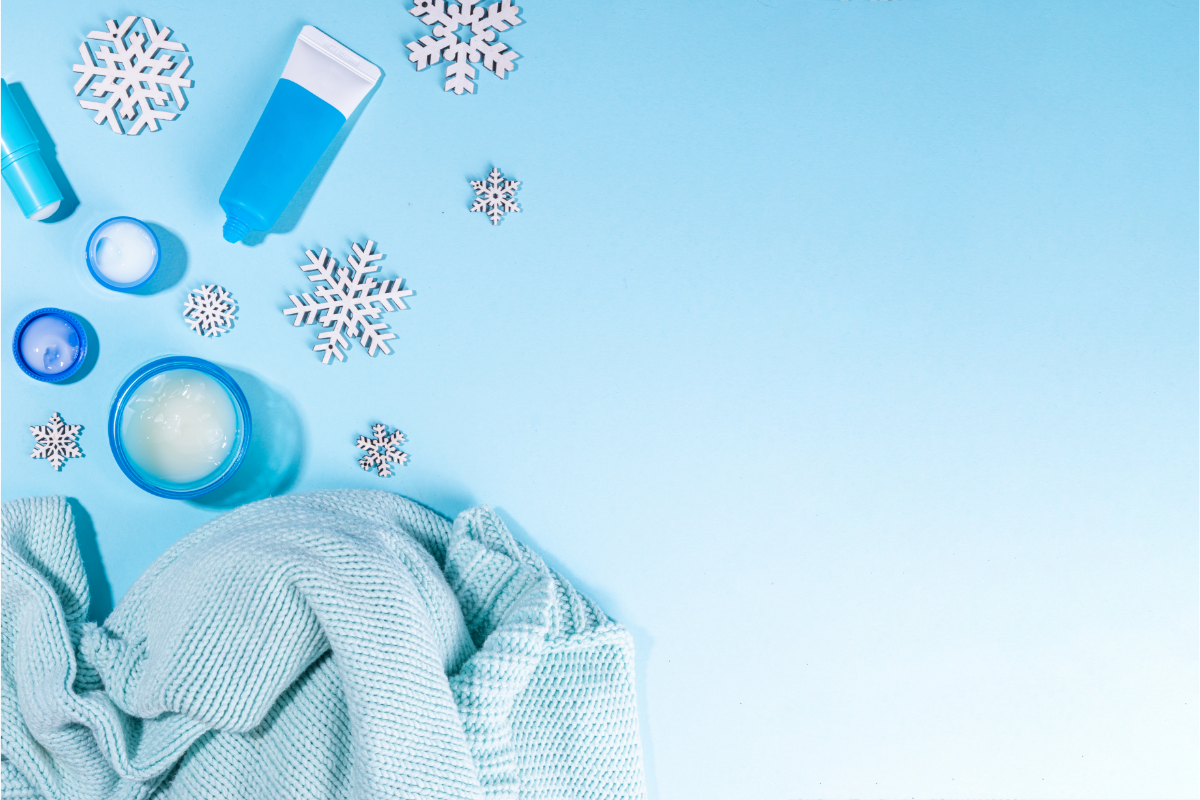To the despair of many, winter is well under way! Scarves, jumpers, hats and gloves will be our best allies for months to come in the fight against the cold. But have you thought about your skin? It’s a well-known fact that winter has no mercy on our skin : ared nose, chapped lips, dry skin, a dull complexion… So what can we do to keep our complexion looking radiant throughout the winter? Discover Soin et Nature’s tips for adapting your beauty routine to the season, with carefully selected skin care products to keep your skin healthy while you wait for warmer weather..
What happens to my skin in winter?
When the seasons change, our skin reacts to environmental variations. In winter, the significant drop in humidity both outside and inside due to heating creates stress on the skin, which manifests itself in different ways to other seasons.
Skin differences between winter and other seasons
In summer, the skin can look oilier and more prone to acne due to increased perspiration and sebum production. Spring and autumn can present a more stable balance, with relative humidity supporting a healthy skin barrier. However, in winter, bitter cold and dry winds can compromise this barrier, leading to a reduction in sebaceous secretion and a deterioration in the skin’s intrinsic hydration.
This reduction in the hydrolipidic film on the skin’s surface allows pathogens and irritants to penetrate more easily, which can increase sensitivity and promote inflammatory reactions. As a result, winter skin requires a tailored skincare routine, which is often richer and more protective than in other seasons.
Common winter skin problems
Common winter skin problems include
- Dry skin (xerosis): Skin that feels tight, flaky and less elastic. Dryness can also lead to the appearance of fine lines and wrinkles.
- Redness and irritation: Cold winds and sudden exposure to the heat of heated interiors can cause redness, particularly on the cheeks and nose.
- Dull skin: The accumulation of dead skin cells, due to slower cell renewal and reduced hydration, can leave the skin looking dull and lacklustre.
- Worsening of conditions such as eczema or rosacea (it all depends on the person – some cases of rosacea are improved by cold weather): The climatic stress of winter can exacerbate these dermatological conditions.
To counter these problems, a proactive approach is recommended, including the use of gentle cleansers and moisturisers rich in ingredients such as ceramides, hyaluronic acid and essential fatty acids. In addition, gentle exfoliation can help remove dead skin cells and promote better absorption of skincare products.
How can I adapt my winter routine to suit my skin type?
Personalising your skincare routine is essential, especially in winter when your skin is exposed to conditions that can exacerbate existing problems or create new ones. An approach tailored to your skin type helps to maintain its balance and prevent seasonal discomforts.
Beauty routine for dry skin
In winter, dry skin is particularly vulnerable to external aggressors, so it’s essential to adopt a rich, nourishing routine. Start with a gentle, sulphate-free cleanser that purifies without dehydrating (Bioderma Cicabio Cleanser, for example). Choose milky or oily formulas. Next, a moisturising mist containing ingredients such as glycerine or hyaluronic acid can prepare the skin to better absorb subsequent skin care products. We recommend applying a serum rich in lipids and antioxidants, followed by a thick cream containing butters such as shea butter or vegetable oils. Don’t forget to seal in the moisture with an occlusive balm in the evening for in-depth repair.
Beauty routine for oily skin
Oily skin needs a delicate balance in winter. It can dry out on the surface but still produce excessive sebum. Cleansing with mild acid-based products, such as salicylic or glycolicacid, will help to regulate sebum production without irritating the skin. The use of moisturisers in gel form or light lotions is recommended to provide sufficient hydration without weighing the skin down. Opt for non-comedogenic products enriched with niacinamide to control shine and reduce the appearance of pores. Particular attention should be paid to moisturising areas that can become dry, such as the cheeks, without going overboard on areas that tend to be oily.
Beauty routine for combination skin
Combination skin, combining dry and oily areas, requires an adaptive strategy to meet these diverse needs. A gentle, moisturising cleanser that respects the skin’s natural balance is a good place to start. Using alcohol-free balancing toners can help prepare the skin. For serums and creams, consider formulas that target specific areas: mattifying formulas for the T-zone and richer, more nourishing form ulas for the cheeks and eye area. Targeted masks applied only to areas requiring specific treatment can also complete this routine. In fact, we call this multi-masking!
Should I use sun cream in winter?
Sun protection is often associated with summer, but it remains essential in winter. Sunscreens contain chemical or physical compounds that block ultraviolet (UV) radiation, which is shorter than visible light and is divided into UVA1, UVA2 and UVB. The shorter wavelength of UV rays means a higher potential for biological damage, so protection against these rays is essential to avoid harmful effects such as photo-induced ageing and various types of skin cancer. Experimental studies have shown that sunscreens protect against cell damage linked to carcinogenesis in animal models, and a well-conducted Australian randomised trial found a 40% lower incidence of squamous cell carcinomas in participants using sunscreen on a daily basis. The same study also found that regular use of sunscreen can stop the signs of skin ageing caused by photo-induced damage.
Is blue light harmful to my skin?
As well as using sunscreen, it’s important to consider protection against blue light, which is a part of the visible light spectrum emitted mainly by the sun, but also by digital screens, LEDs and fluorescent lighting. Although blue light can have beneficial effects, such as preventing certain skin diseases with low-energy, short-term exposure, prolonged exposure to high-energy blue light can increase DNA damage, cell and tissue death, and photo-induced ageing. This suggests the importance of cosmetic formulas that can protect the skin against these negative effects of blue light.
Sun protection: Winter beauty essentials
These facts demonstrate the importance of overall skin protection in winter, which includes not only the use of adequate sun protection but also taking into account the effects of blue light. We recommend using skincare products with appropriate sun protection factors (SPF) and, wherever possible, applying these products generously to ensure effective coverage.
Cleanse and soothe skin discomfort
When the mercury drops, the skin becomes more sensitive and dry. In winter, more than in any other season ,adopting a ‘cold season’ beauty routine combining cleansing, moisturising and protective products is essential .
To do this, we recommend the products in the Jonzac Réactive range, specially formulated to gently cleanse and promote the regeneration of damaged skin cells.
- Jonzac Réactive Lait Dermo Nettoyant – With its creamy texture, this gentle lotion made with 25%Jonzac thermal spring water combined with a synergy of floral waters (Mallow, Camomile, Witch Hazel) removes make-up and impurities from the face and eye contour area without irritating them . On the contrary, its organic ingredients, chosen for their softening and astringent properties, soothe reactive to intolerant skin, the main victims of winter redness. Use morning and night to preserve your skin’s radiance
- Jonzac Réactive High-Tolerance Rich Cream 40 ml – Thanks to a judicious combination of thermal spring water, phytosphingosine and shea butter, this cream relieves the tingling, tightness and itching that occur with cold weather, from the very first application. It also has nourishing and protective properties that care for and beautify the skin, helping it to withstand the rigours of the extreme cold. Use daily to keep your skin soft and healthy!
Vitality and radiance: optimising your beauty routine in winter
- Enhancing the look of your eyes: The periocular epidermis, which is extremely thin, suffers intensely from the onslaught of winter. It is essential to use specific eye care products, enhanced with anti-ageing agents such as retinol or vitamin C, to reduce the shadows of dark circles and signs of fatigue.
- Stimulate the skin with facial massage: The face, often puffy when waking up in the winter, needs to be toned up using facial massage techniques. Daily use of accessories such as the Gua sha or the jade roller encourages skin microcirculation, resulting in a revitalised complexion and revitalised skin.
- Lip care: don’t neglect your lips: Lips are exposed to the cold and need constant care. A balm rich in repairing agents, such as cocoa butter or coconut oil, is essential and should be reapplied regularly to keep them supple and prevent painful cracking.
- The importance of a balanced lifestyle: External skin care is just one aspect of skin well-being. Adopting a diet that favours fresh, natural foods and is rich in essential nutrients such as omega-3 and antioxidants, as well as regular physical activity, are the internal pillars of healthy skin, contributing to its radiant appearance in winter.
How can I recognise which ingredients are good for my skin in winter?
| Active ingredient | Function | Action on the skin |
|---|---|---|
| Ceramides | Reinforces the cutaneous barrier | Restores the skin’s natural lipids, reinforces its barrier and prevents dehydration. |
| Hyaluronic Acid | Hydration | Attracts and retains water in the epidermis for deep hydration and a plumping effect. |
| Omega Fatty Acids | Nutrition | Nourish the skin, repair tissues and provide essential lipids for supple skin. |
| Glycerin | Moisturiser | Humectant that attracts water, increases the water content of the epidermis and maintains skin hydration. |
| Niacinamide (Vitamin B3) | Improves complexion | Reduces inflammation, diminishes redness and evens out skin tone. |
| Shea butter | Emollient | Provides fatty acids to soften and smooth the skin while offering protection against the cold. |
| Salicylic Acid | Exfoliation | Helps eliminate dead skin cells, purifies pores and can reduce imperfections. |
| Vitamin E | Antioxidant | Protects the skin from free radical damage and strengthens the skin barrier. |
| Allantoin | Soothing | Soothes irritation and promotes cell regeneration for soothed skin. |
| Aloe Vera extract | Soothing and moisturising | Intensely moisturises and calms redness and irritation caused by the cold. |
Source :
- Epub 2020 Nov 28. Blue Light Protection, Part I-Effects of blue light on the skin
- The efficacy and safety of sunscreen use for the prevention of skin cancer Megan Sander, Michael Sander, Toni Burbidge and Jennifer Beecker. CMAJ December 14, 2020







